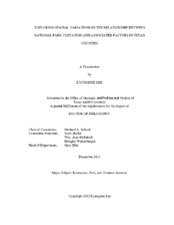| dc.description.abstract | Recreation demand such as national park visitation is influenced by various social, demographic, and economic factors. These key variables are important indicators in predicting future trends and provide beneficial information about potential park visitors for managers and planners. As parks and protected areas become impacted by socio-economic changes, it is important to understand the relationship between specific factors of recreation participation and national park visitation. From a practitioner perspective, recreation agencies require multi-scale levels of information in order to address visitor and facility needs. While site-based research or using disaggregated models are helpful to satisfy specific purposes for a park, they often do not provide this information in spatially distributed data on a statewide or regional level. Recreation planners and managers need recreation demand forecasts at levels of spatial aggregations.
This study tried to identify the spatial relationships between national park visitation and its associated factors using large aggregated data. Guided by the idea of opportunity theory and Pigram’s conceptual framework, this study empirically investigated what and how factors associated with national park visitation influence demand within the Texas boundary. Specifically, this study developed a spatial regression model of national park visitation demand in Texas using Geographically Weighted Regression (GWR). This model estimated the strength of the relationship between visitation and selected demographic, socioeconomic and situational factors. Methodologically, traditional regression models (e.g., OLS) yield only a single estimate in a relationship. In comparison, GWR allows an estimate of the spatial variation of the relationship within the study area. Several private and public data sources were used in the model to create reliably aggregated data. Several explanatory variables, e.g., poverty rate, family structures, recreation-related spending patterns and level of education, were hypothesized to influence the level of national park visitation for spatially varying relationships across the study area. From a methodological perspective, this study found interesting methodological implications (e.g., rethinking the traditional regression model for recreation demand estimation) and the potential associated with the use of spatial statistics to analyze the relationships between recreation participation and societal factors. This research demonstrated the importance of including spatial variables as part of recreation demand analysis. Relatively little work has used spatial models in the field of recreation. The results of this study demonstrate the usefulness of spatial analysis for detecting various relationships within the state over traditional statistical analysis. | en |


